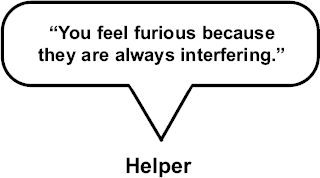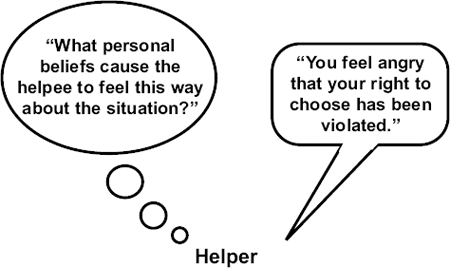Personalizing meaning is the first step toward facilitating the helpees’ understanding of where they are in relation to where they want or need to be. We personalize the meaning when we “add” to the helpees’ understanding of the mean ing of their experiences.
In responding “interchangeably” to meaning we answered the questions: “What is the situation?” and “How does the helpee feel about it?” In personalizing meaning we answer the questions: “What are the effects of the situation upon the helpee?” (Implications) and “What personal beliefs cause the helpee to feel this way about the situation?” (Assumptions).
Personalizing meaning involves building on common themes to formulate and communicate the implications of the helpees’ experiences for the helpees. Personalizing meaning also involves formulating and communicating the helpees’ assumptions. These personal assumptions explain “why” they feel this way.

PERSONALIZING MEANING
Just as we formulated interchangeable responses to individual helpee expressions, we now formulate interchangeable responses to helpee expressions made over a period of time. We do this by looking for the common themes in the helpee’s expressions. The themes relate to what the helpees are saying about themselves. The common themes are those themes that are interwoven through more than one of the helpee’s expressions. When one common theme stands out above others because of recurrence or intensity, we may call it a dominant theme. We now formulate interchangeable responses to the helpee’s expressions made over a period of time.

IDENTIFYING COMMON THEMES
We personalize meaning by considering the personal implications for the helpees. We do this by asking ourselves, “What are the effects of the situation upon the helpees?” We are looking at the personal consequences of their experiences.
We are “additive” when we formulate and communicate information about implications for the helpees that they cannot or will not articulate for themselves. We formulate our personalized responses to meaning by searching our own experiences and our own understanding of implications. We build upon what the helpees’ tell and show us, and extend their understanding of the implications of their experiences and their role in it.
When we communicate a personalized response to meaning, we may use the format: “You feel ________ because you (personal implications).”

PERSONALIZING IMPLICATIONS
We also personalize meaning when we consider the personal assumptions of the helpee. We do this by asking ourselves, “What personal beliefs cause the helpee to feel this way about the situation?” We are looking for the helpee’s personal assumptions about the situation. By “personal assumptions” we mean those beliefs that the helpee holds as accurate or true.
We are “additive” when we formulate and communicate information about the assumptions that the helpees cannot, or will not, articulate for themselves. We formulate our personalized responses to meaning by searching our own experiences and our own understanding of assumptions. We build upon what the helpees tell and show us, and extend their understanding of their personal assumptions about their experiences and their role in it.
In personalizing meaning, we may use the format: “You feel ________ because you (personal assumptions).”

PERSONALIZING ASSUMPTIONS
We must continue to check back with the helpees to stay in tune with their experiences. In so doing, we may find that their feelings are changing. If we do not have a precisely accurate feeling response, we continue to work on answering the feeling question, again asking ourselves, “If I were the helpee, how would I feel?”

PERSONALIZING CHANGING FEELINGS ABOUT MEANING
The behavioral responses of the helpees will tell us if our personalized responses have been effective. Do the helpees integrate better ideas and better responses? Do the helpees engage in exploring new meanings (assumptions and implications) of their experience?
The helpees inform us of their readiness to move beyond discussing the meaning of their experiences when they demonstrate their ability to formulate and communicate their understanding of the assumptions and the implications of their experiences. In other words, the helpees inform us by doing for themselves the things that we have been doing for them.

HELPEES SIGNAL THEIR READINESS TO BEGIN UNDERSTANDING PROBLEMS
